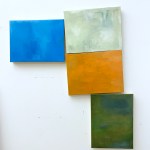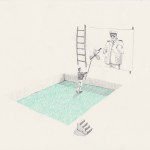
Long, long ago, when paint-on-canvas art making was deemed irrelevant, painters began exploring experimental processes to make painting-like wall pieces that might wrest the conversation away from “new media” back toward object-making. One such artist is Rudolf Stingel. Nahmad Contemporary presents some of Stingel’s 2001-03 Styrofoam and Celotex Tuff-R panels that were created during installations and performances at the Fran�ois Pinault Foundation, the Museum of Contemporary Art, Chicago, the Whitney Museum of American Art, and the 2003 Venice Biennale.
[Image at top: Rudolf Stingel, Celotex panel, detail.]

Rudolf Stingel
Throughout this period, Stingel used destructive processes like chemical melting, tearing, gouging, and scraping. He covered entire rooms with Celotex Tuff-R, a type of insulation panel covered in reflective material, and then he let visitors, who could see their blurry reflections in the mirror-like finish, draw, write, and deface them. Lucio Fontana’s slashed canvases, Arte Povera artists’ use of industrial materials, and the graffiti-like mark-making of Jean Dubuffet and Cy Twombly are some of the references cited in Stingel’s press materials.

For his Styrofoam pieces (image above), Stingel put the large panels on the floor, soaked his boots in chemicals, and walked across them, leaving a path of oozy destruction where the chemicals ate away the Styrofoam. Sometimes he glued other pieces on top. In contrast to the Ab-Ex generation, Stingel saw himself as an anti-hero, turning ordinary materials and a mundane act into unexpected art. Unfortunately, I kept thinking that the gallery looked like a film set for a Ben Stiller satire about art world pretentiousness.
Rudolf Stingel, installation view.
At the Met, I saw the first painting Alex Katz made of his wife Ada. Oil on masonite, this beauty was painted in 1957 before Katz had fully developed the austere figurative style for which he is known. Katz married Ada in 1958, and over the years he has painted more than 250 canvases of her. This one is on view in “Alex Katz at the Met,” through June 26.
Nearby at CG Boerner on East 73rd Street, “Jane Kent and David Storey: Intimate Works,” a charming show of paintings, drawings, and prints just closed, but here are a few images.
Jane Kent, gouache on mezzotint printed ground, 23 1/2 x 17 1/2 inches.
David Storey, The Pipes, oil on canvas, 8 x 10 x 3/4 inches.
David Storey, Visionary, oil on canvas, 14 x 11 x 3/4 inches.
David Storey, installation view
Jane Kent, installation view.
In the same cozy brownstone, Van Doren Waxter has an exhibition of Diebenkorn gouache and ink abstractions from 1949-55, some of which I liked very much.
Richard Diebenkorn, Untitled, c. 1949-55, gouache and graphite on paper, 11 1/2 x 10 inches.

Richard Diebenkorn, installation view.
Two Coats of Paint is licensed under a Creative Commons Attribution – Noncommercial-No Derivative Works 3.0 United States License. To use content beyond the scope of this license, permission is required.





























"…a film set for a Ben Stiller satire about art world pretentiousness.". What?
Yeah, I get that feeling, too, Sharon. I totally love these Stingel's panels …..but maybe to the rest of the world we all look like idiots?